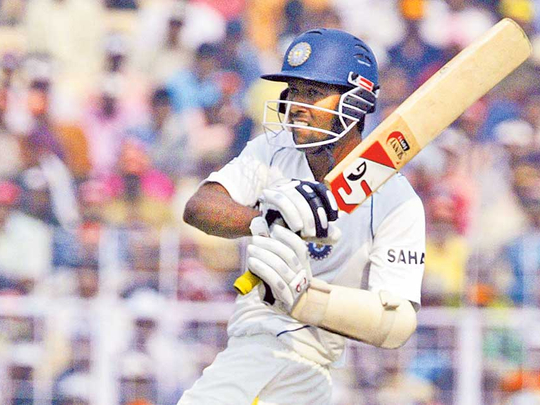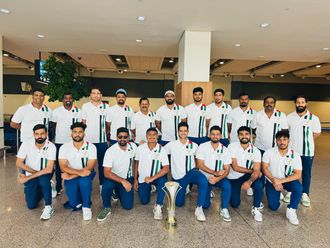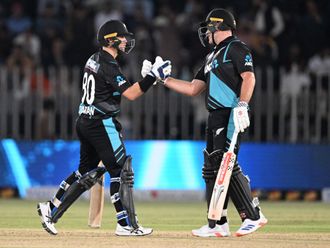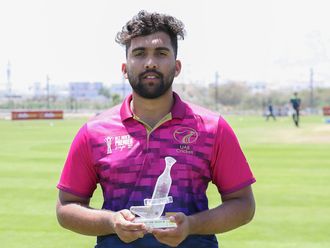
Dubai: There are many cricketers in India who despite their enormous talent could never cement their place in the Indian team. Some have been so unlucky they could not even clinch a place in the Indian team despite their consistent performance in India’s domestic cricket. Mumbai born Waseem Jaffer was one such player who began his career with such promise but could not rise to level he deserved to reach.
Jaffer despite being ignored by selectors at the age of 28 from internatoinal cricket, never let his spirits go down and continued to score heavily in domestic cricket. Last week he created history by becoming the first batsman in the history of Ranji Trophy, India’s top domestic tournament, to cross the 10,000 run mark. The fact that no batsman for the last 82 years of this tournament since it commenced in 1934-35 could pile up so many runs reveals the enormity of his achievement. It also speaks of his determination to keep performing despite huge setbacks.
Jaffer scripted history while playing for Vidarbha instead of his home state Mumbai. This 37-year-old reached the milestone in his 126th match and is now the leading run-getter in Ranji, Duleep and Irani Trophy having amassed 10002, 2545 and 1008 runs respectively. Interestingly, Jaffar went past former Mumbai teammate Amol Muzumdar with 9202 runs followed by Delhi’s Mithun Manhas with 8197 runs in the list of leading run-getters in Ranji Trophy. Muzumdar and Manhas never got selected to the Indian team making it clear that selectors have never bothered to give importance to consistent performers in India’s leading domestic tournament while selecting the Indian squad.
Jaffer has played 229 first-class matches with 51 centuries and 83 half-centuries and amassed 17088 runs. Speaking after reaching the land mark Jaffer revealed that it was nothing but his passion to play cricket that kept him going. His comment that ‘it’s not just about scoring runs; the more important challenge is how you can get better every day. I took it up as a challenge.” is a lesson for cricketers who give up the game following a few setbacks.
The tale of Jaffer’s career is a moving one. He did not hail from a well to do family like most Mumbai cricketers. He was the son of a driver with BEST (Brihanmumbai Electric Supply and Transport) who supported his son’s dreams to become an international cricketer. He hardly had the salary to buy his son a good cricket bat but still managed it despite the bat costing a huge percentage of his salary.
My first encounter with Jaffer was while I was a reporter in Mumbai when he was scoring heavily in schools cricket. When he hit an unbeaten 400 as 15-year-old boy in inter school cricket against Marwadi Vidyalaya in the Giles’ Shield quarterfinal he was featured as the rising star in most Mumbai newspapers He soon got picked up to the Bombay Under-16, and also found him a berth in India Under-19 team. He smoothly made his first class debut and proved his talent in his second match with a triple century. From them on he set many new marks.
The fact that he reached a landmark in Ranji Trophy which even greats like Sunil Gavaskar and Sachin Tendulkar from his city of birth could not do it must have been very pleasing. Gavaskar scored 5335 runs while Tendulkar piled up 4281 runs only in Ranji Trophy.
Jaffer had a tough Test debut in February 2000 against South Africa with pacers Alan Donald and Shaun Pollock at their best. He could score only 46 runs in his first four innings. Jaffar got dropped for two years after that with a label of not a good player of pace though many others too failed against Donald and Pollock’s pace. After a wait of nearly two years he got selected again for a tougher tour to West Indies. He cracked 51 at Bridgetown and 86 at Antigua. He also hit a 53 against England at Lord’s and then he was dropped for four years. He staged a brilliant comeback in 2006 Nagpur Test match against England hitting 81 runs in the first innings and 100 in the second innings.
Jaffer’s Test career lasted only two more years despite hitting a double century against Pakistan in Kolkata in November 2007. From then on India’s domestic cricket was the only stage he got to display his talent and he made full use of it to carve out a niche for himself as the best.












